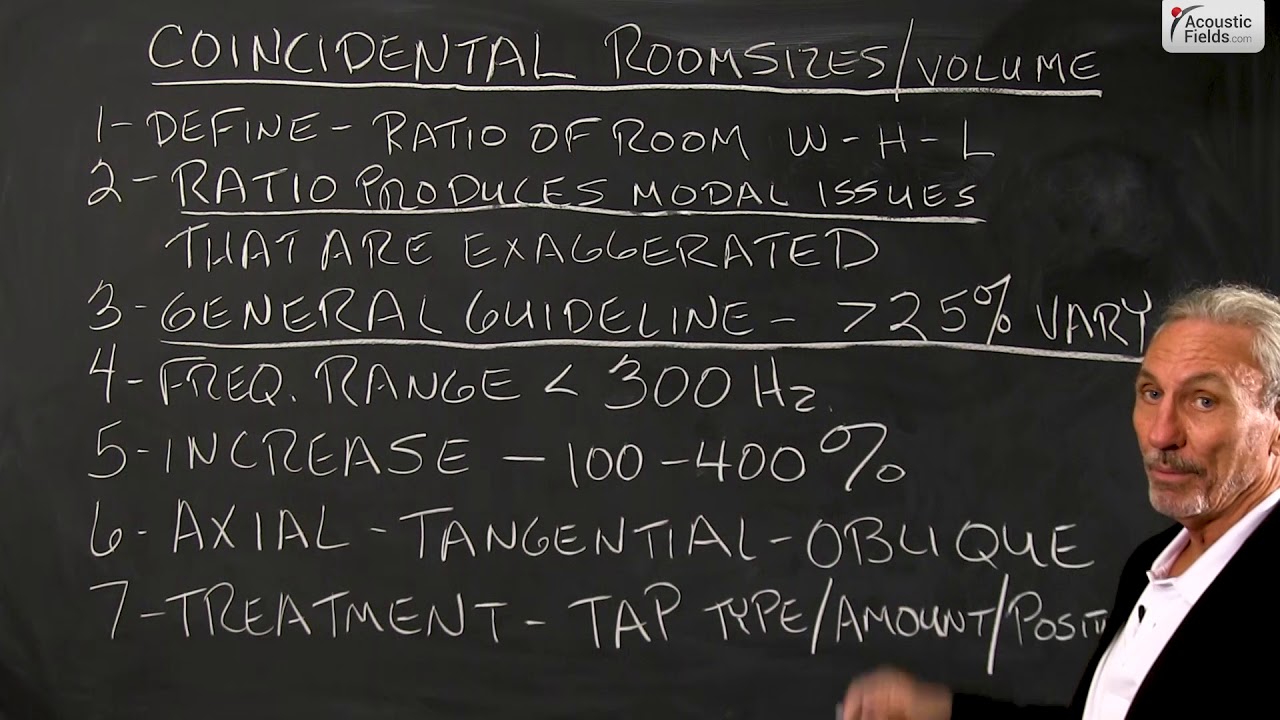Let’s talk about coincidental room sizes and volumes so we can kind of get a handle on what this term “coincidental” means. It’s a fancy term for more of something we don’t want. I think it’s the easiest way to say it. It’s all about the ratio of the room: the width, the height and the length. Sometimes we get widths, heights and lengths that are so close to each other that they just compound all the problems we’re going to have to deal within the room.
I think you’ve all heard about the cube effect where you get a room that’s perhaps 12/12/12. Wouldn’t it be nice to have a 12 foot ceiling? Not so nice to have a 12 foot width and not so nice to have a 12 foot length. There’s a thing that happens especially with frequencies below 300 where everything gets exaggerated exponentially. So let’s talk a little bit about that.
We all know from past videos that it’s the ratio of the room with our height, width and length that produces how much modal pressure issues we’re going to have below 300 cycles and how severe they’re going to be. I’ve seen some rooms recently with +19 dB bumps below a 100 cycles. These are very small rooms. So when you have that kind of situation you have to be very careful but you have to be extremely careful with the coincidental room sizes and your ratios.
So what’s a good thing to follow? A good guideline is try to vary your dimensions. I don’t care what they are, width, length, or height, by at least 25% starting out. So we want to make sure that we have at least a 25% variance in each. The ceiling varies 25% at least from the width and the length. The width varies 25% from the height and the length and etc.
So a good general guideline, will that work in all situations? No. That’s the definition in general. But use that guideline when you’re out looking for a room. And if you get in a situation, you’re buying a new property, you’re getting a new house, you’re moving, get me the room dimensions before you move and if you’re moving because that’s what you have to do and that’s what you want to do, we can probably look and see if that’s going to work for your situation, okay?
What does it do? Well, we know the frequency range of all these problems that small rooms are always below 300 cycles. That’s our field of play, that’s where we work, that’s the area I constantly work in because anything greater than 300 cycles, I can manage with diffusion and absorption. I can manage with quadratic diffusion and foam. Everything below 300 cycles I’ve got to use diaphragmatic absorption, I’ve got to use membrane and in some cases Helmholtz.
So it’s a completely different sets of treatments. And if I’m going to have an increase in all my problems by 100% to 400% because I have coincidental room size problems, it’s going to be tough. There’s going to be certain things you can’t do in the room. One, make a living, if you’re a professional. So it’s going to be very difficult. So we have to always define that. If you’re a hobbyist, yeah, you can work around the problems but if you’re a professional you won’t be able to. So there’s just certain room ratios that won’t work. So be very, very careful.
So remember our 3 modes: axial, tangential and oblique. Axial is two parallel surfaces. Sidewall, sidewall, floor to ceiling, front to rear. And then the tangential are that crosses the floor and then the obliques are corners to corners. So 4 surfaces, 2 surfaces, 6 surfaces. So be very, very careful when you’re choosing a room, not to get ratios and sizes that are so close. Try to vary them by 25% at least. Because that will influence – remember our acronym, TAP – the amount, the type of treatment you’re going to use, how much you’re going to use and where you’re going to put it.
So I hope that helps. Coincidental room sizes and volume. Try to vary the dimensions of your room by at least 25% to start.
—
This is an unedited transcript from our video series from Acoustic Fields. There will be some errors in grammar and sentence structure that occur during this translation process.
For complete understanding and comprehension, please view the video which is included in this text. For any additional information regarding this topic or others relating to room acoustics, please contact us directly at:
P: 520 – 392 – 9486








great video – thnk u
F,
Thank you for your support.
Coincidentally, my room is definitely coincidental. I should add that I’m a hobbyist. My question concerns the placement of my DIY 4″ wool absorbers. I would like to stand them in the corners but the floor molding creates about a 1/4″ gap from them sitting flush with the adjoining walls. So it’s an “open” triangle (if you were looking down from the ceiling). Will they be more effective sitting tight against the walls? Thank you for sharing your knowledge.
T, Don’t be concerned with a 1/4″ gap. What is the depth of your “wool absorbers”? Are they really made out of wool?
Thank you for your response! They are 4″ thick mineral wool 2’x4′. I can now stack them in the corners. I really appreciate your videos and sharing your knowledge with hacks like me. TM
Sir,
I have my room size of L 20,H 10 and W 13.Is this room a perfect One for 5.1 mixing studio
Thank you
S, There is no such thing as a perfect room. Fill out the information in this link: https://acousticfields.com/free-room-analysis/
My room is 9 ft high, 15ft wide and 26ft long.
Is this room a good room?
B, What is the usage of the room.